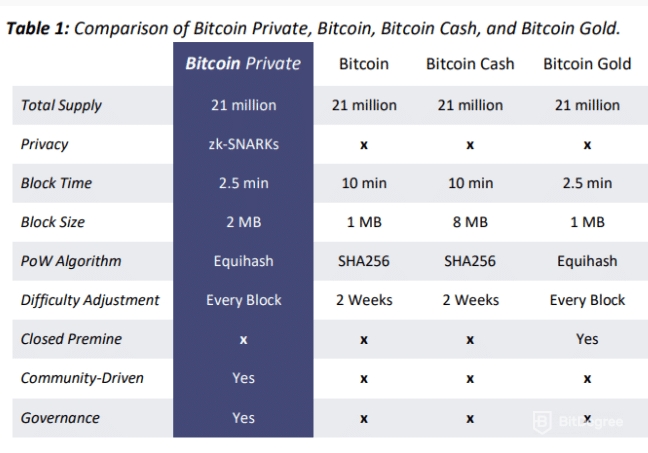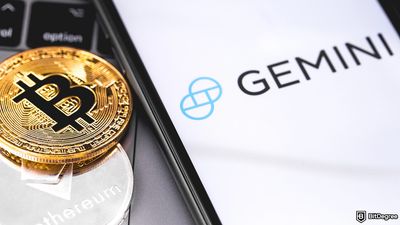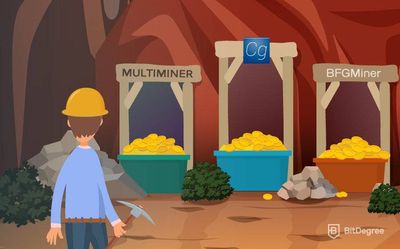The cryptocurrency and blockchain technology industry have created lots of new and exciting terms. One of these terms is Fork. And no, this isn’t the thing you use to eat your food with!
In this guide, I am going to explain everything you need to know about these newly presented forks. I will start by explaining what a BTC fork actually is, followed by a discussion on some of the most popular and well-known forks over recent years.
After that, I will then talk about a couple of Bitcoin forks that are planned for the future, followed by my opinion on whether or not I think Bitcoin will always be the number one cryptocurrency.
So, what are you waiting for? We’ve got lots to discuss, but let’s start by finding out what this innovation actually is!

Did you know?
Want to get smarter & wealthier with crypto?
Subscribe - We publish new crypto explainer videos every week!
What is Staking Crypto? (Rewards & Risks Explained SIMPLY)


Table of Contents
What is BTC Fork?
In its simplest form, it is when somebody creates a copy of the Bitcoin blockchain code and makes changes to it. These changes can be made for a number of reasons, such as the previous blockchain being hacked, or because improvements need to be made. Generally, there are two types of blockchain forks — a ‘soft fork’ and a ‘hard fork’.
Latest Deal Active Right Now:
$600 WELCOME BONUS
Binance Black Friday Deal
If you're new to Binance, great news - this Binance Black Friday period, you can earn up to $600 in rewards. Sign up, use the code 49316610, and start earning now!
A soft fork is easier than a hard fork, as only small changes are made to the blockchain. A soft fork is known as "backward-compatible" because while old transactions are no longer valid, new transactions are recognized by both old nodes and new nodes. For a soft fork to be successful, it needs to receive a “majority consensus”, which is like a public vote.
A hard Bitcoin fork is slightly different as it essentially creates a new blockchain. Bitcoin Cash is a famous example of a Bitcoin hard fork. As most blockchains like Bitcoin are open source, anybody can view and copy the code, meaning that a Bitcoin hard fork can be performed by anybody.
So, now that you know what this innovation actually is, the next part of my guide is about some of the most famous Bitcoin reworks of all-time!
The Most Popular Ones
Bitcoin Cash
In 2017, a group of influential Bitcoin developers decided to perform a hard fork of the Bitcoin client, which resulted in a completely new cryptocurrency and blockchain being created, Bitcoin Cash (BCH).
The main reason behind this Bitcoin split was because Bitcoin transaction fees were becoming too expensive. In fact, in what started as less than a cent in 2009, it quickly increased to a few dollars per transaction.
However, before the hard Bitcoin fork was performed, the group of developers tried to convince the Bitcoin community to make the required changes within the original Bitcoin client.
The changes that a team of developers wanted to make was to increase the maximum block size from 1MB to 8MB. This would allow miners to add more transactions into a block, which would have reduced the fees that Bitcoin users pay to transfer funds.
Remember how I said a soft fork needed to receive the majority vote? Well, unfortunately, the majority of Bitcoin users didn't want to make the change, so they had to create a whole new blockchain.
The Bitcoin Cash blockchain was officially launched on 1st August 2017. Just like Bitcoin, the Bitcoin Cash supply is limited to 21 million coins and each block takes 10 minutes before it is confirmed.
On the other hand, as the maximum block size was increased by eight times, it allowed the Bitcoin Cash blockchain (or Bitcoin fork) to scale more transactions. Scalability (or scaling) is the maximum amount of transactions that a particular blockchain can process every second.
Bitcoin is very limited in this sense as it can only process an average of 7 transactions per second. This is one of the things that are currently letting Bitcoin down — if it is going to be used as a global payment system, it must improve its scalability performance.
 Source: cointelegraph
Source: cointelegraph
Due to the changes that were implemented after this Bitcoin split, Bitcoin Cash can process about 61 transactions per second.
Interestingly, anybody that was holding BTC on the day of the Bitcoin split received exactly the same amount of Bitcoin Cash (BCH) coins. What this means is that if you held 0.5 BTC, you would also receive 0.5 BCH when Bitcoin Cash launched.
Since this Bitcoin fork was launched, it has been a very successful project. In fact, at the time of writing in June 2018, it is the fourth most valuable cryptocurrency in the industry. In December 2017, BCH reached its all-time high of over $4000, with a total market capitalization of just under $70 billion!
The main person behind the Bitcoin Cash project is a well-known cryptocurrency investor called Roger Ver. Ver, often referred to as "Bitcoin Jesus", believes that Bitcoin Cash is actually the "Real Bitcoin", and he thinks it will overtake Bitcoin as the number one cryptocurrency.

Bitcoin is the most important invention in the history of the world since the internet.
Investor in bitcoin-related startups,
Roger Ver
So, now that you know about the Bitcoin Cash fork, the next Bitcoin hard fork that I wanted to discuss is Bitcoin Gold.
Bitcoin Gold
The BTC Gold is a Bitcoin fork blockchain that was officially launched in October 2017. While Bitcoin Cash was concerned with reducing transaction fees, the people behind Bitcoin Gold wanted to make Bitcoin more "decentralized".
Although Bitcoin is still technically decentralized, and the system is not controlled by any single authority, nor is it backed by any central bank or nation-state, there are still some concerns with the way that transactions are verified/mined.
This is because the vast majority of Bitcoin mining is controlled by just a few pools in China. A mining pool is where lots of people “pool” their hardware resources together to give them a better chance of winning the mining reward.
Once the Bitcoin reward is won, it is divided between the pool, based on how much each person has invested. Ultimately, this gives the people running the mining pool lots of power and influence over the network, which is why some believe that this Bitcoin fork has become too centralized.
In the early days before mining pools became dominant, it was possible to mine Bitcoin by using a basic CPU or GPU, meaning that anybody could do it in the comfort of their own home. Those days are now long gone if you want a chance of winning the reward — not only do you need to be part of a mining pool, but you also need to own really expensive ASIC hardware.
But guess who manufacturers a lot of the mining hardware? One of the largest mining pools in the industry!
In response, Bitcoin Gold installed a new mining process that makes sure that specialized and expensive hardware cannot be used to increase somebody's chances of winning the mining reward.
Think about it like this:
If a Ferrari raced 10 Mini Cooper's, which car do you think would win? Well, obviously the Ferrari as it has the most powerful engine! However, Bitcoin Gold changes things so that instead of a Ferrari being in the race, there are just 10 Mini Coopers, giving everybody a fair chance of winning.
Just like both Bitcoin and its Bitcoin fork BTC Cash, Bitcoin Gold will limit its BTG coin supply to a maximum of 21 million. Furthermore, the maximum block size of 1MB wasn’t increased either. However, instead of taking 10 minutes like Bitcoin, Bitcoin Gold can confirm a transaction in just 2.5 minutes, making it four times faster!
The other major difference is the way that miners verify transactions. Interestingly, Bitcoin Gold also uses Proof-of-Work (just like Bitcoin), but it has been modified to only allow GPU’s to mine, not ASIC’s.
Just like the Bitcoin Cash fork, anyone holding Bitcoin at the time of the launch received identical amounts in Bitcoin Gold.
Since it was launched, Bitcoin Gold has also performed really well. The BTG coin hit its all-time high in December 2017, reaching just under $8 billion in market capitalization.
However, in May 2018 Bitcoin Gold experienced the much feared “51% attack”. This is when somebody (or a group of people working together) are able to gain 51% or more of the total blockchain hashing power, meaning that they are temporarily able to make changes to the network. This resulted in just over $18 million of Bitcoin fork BTG coins being stolen and converted at a third party exchange.
This attack is actually quite ironic because the whole point of Bitcoin Gold was to prevent centralized miners from gaining too much control. As a result, it is believed that the developers are planning to perform a fork of the Bitcoin Gold code, to ensure that it won’t happen again.
So, now that you know about the Bitcoin Gold fork, the next part of my BTC fork guide is going to talk about Bitcoin Private!
Bitcoin Private
Bitcoin Private was officially launched in March 2018, however, it wasn’t actually a direct fork of the original Bitcoin. Here’s where things get a little complicated:
- Bitcoin Private was forked from a blockchain called ZClassic.
- ZClassic was forked from a blockchain called ZCash.
- ZCash was forked from the original Bitcoin.
Its founder and main developer, Rhett Creighton, also created ZClassic and since then, others have joined the team. The idea Creighton had was to combine the privacy and secrecy of ZClassic with the security and popularity of Bitcoin.
Just like in the other Bitcoin forks I have discussed, anyone holding BTC at the time of the launch was awarded a 1:1 supply of Bitcoin Private (BTCP). Furthermore, anyone holding ZClassic (ZCL) was also awarded a 1:1 supply. This means that if you were holding both BTC and ZCL, you would have received Bitcoin Private coins twice!

In total, there will be a maximum supply of 21 million BTCP coins. The block size is double the size of Bitcoin at 2MB and it is also able to confirm a transaction four times faster.
Furthermore, just like Bitcoin fork BTC Gold, the mining mechanism has been modified to prevent people from using expensive hardware, meaning that it is a much fairer and equal network than Bitcoin. To clarify, it also uses the Proof-of-Work consensus mechanism.
Not only is Bitcoin Gold much faster and fairer than the original Bitcoin, but as its name suggests, it also allows more private transactions too. Just like the ZClassic blockchain, Bitcoin Private uses something called "ZK-Snarks".
Although each movement of funds is still posted to the public ledger, both the sender and the receiver remain private. This is slightly different from the original Bitcoin, as although the real-world identity of the sender and receiver are not revealed, it is possible to find out how much a certain Bitcoin address has. Not only that, but you can also see how much a particular address has sent and received in the past.
Since Bitcoin Gold was launched in March 2018, it has reached an all-time high of just over $1.5 billion in market capitalization, which it achieved in April 2018.
So, now that you know about Bitcoin Cash, Bitcoin Gold and Bitcoin Private, the final Bitcoin fork that I wanted to discuss was Bitcoin Diamond!
Bitcoin Diamond
Bitcoin Diamond was directly forked from the original Bitcoin client. The main focus of its development team was to allow users to remain even more anonymous. In this sense, its purpose is very similar to Bitcoin Private.
When it was first launched in November 2017, Bitcoin Diamond distributed their coins in a slightly different way to the other Bitcoin forks I have mentioned. While the others all kept their total supply to 21 million coins, Bitcoin Diamond increased this by 10 times. As a result, if you held 0.5 BTC at the time of the fork, then you would have received 5 Bitcoin Diamond coins (BCD).
Just like Bitcoin Cash, the maximum block size was increased from 1MB to 8MB, and its transaction confirmation time is 10 minutes. Some people in the cryptocurrency community believe that Bitcoin Diamond is a scam, with many not happy that the team didn't even release a white paper.
At the time of writing in June 2018, all we know about the founders is that they were originally Bitcoin miners, going by the name of “Team Evey” and “Team 007”. Either way, it has reached an all-time high of just under $1 billion in market capitalization, which it achieved in April 2018.

Did you know?
Want to get smarter & wealthier with crypto?
Subscribe - We publish new crypto explainer videos every week!
What are Stablecoins, Altcoins & Wrapped Coins Explained!



- A very well-known crypto exchange platform
- More than 500 different cryptos available
- Two-factor authentication
- Over 500 different cryptocurrencies available
- Strong security
- Small withdrawal fees

- Very low trading fees
- Exceptional functionality
- Mobile trading app
- Very competitive trading fees
- An intuitive mobile app
- Up to 100x leverage available

- Secure and reliable
- Low fees
- A good amount of fiat currencies accepted
- Reputable exchange
- Multiple fiat currencies are accepted
- Relatively low trading fees
Comparison Table
If you have read this Bitcoin Fork guide up to this point, you now have a good idea of the most popular forks that have happened so far. Before we move on, take a look at the below comparison chart, which compares the main features of the different forked blockchains.

Upcoming BTC Forks
Before I continue, I want to mention a few important things that you should consider if you are holding Bitcoin and expecting some free coins from any upcoming Bitcoin forks.
- Never send Bitcoin to another address just because a newly forked blockchain has told you to. If the fork is legitimate, then the coins will be available based on your current holdings.
- If the newly forked blockchain asks you to send them your private keys, don’t do it. This is most definitely a scam.
- Always research the fork yourself. Many new blockchains use the Bitcoin “brand name” to try and convince users that they can be trusted. This isn’t always the case.
Anyway, now that’s out the way, we can take a look at some upcoming forks. Both of the below upcoming BTC forks are still in the development stage, so we don’t have an exact Bitcoin forks date yet, nor is any of the pre-released information final.
Anonymous Bitcoin: This project is looking to combine Proof-of-Work and Proof-of-Stake to improve the way transactions are mined. They also plan to use the ZK-Snark technology I mentioned earlier (Bitcoin Private).
BitcoinZeroX: This Bitcoin fork date is scheduled for September 2018, however it is yet to be confirmed. The fork will be a combination of Bitcoin and Hexxcoin. The aim of this BTC fork is to create an even more anonymous blockchain than Bitcoin Private. Everyone holding Bitcoin, Hexxcoin or both, will receive BitcoinZeroX on a 1:1 basis.
Will Bitcoin Always Be Number One?
As you probably know, Bitcoin is the first and original cryptocurrency. When it was launched in 2009, the main purpose of Bitcoin was to create a global payment system that could be used by anyone in the world, without needing transactions to be confirmed by a third party.

However, even though Bitcoin is coming up to its tenth year of trading, transaction times are still very slow at just 10 minutes. Furthermore, the network can only handle around 7 transactions per second and transaction fees seem to be getting higher and higher.
There are lots of other blockchain projects that can handle faster, cheaper and more efficient transactions, which makes them much more suitable for a global payment system. Although the Bitcoin team is looking to solve this with the introduction of the 'Lighting Network' upgrade, there is no guarantee that it will be able to solve its performance levels.
Therefore, although I think Bitcoin will always be the number one cryptocurrency in terms of usage, value and market capitalization, I don’t think it will be adopted as a global payment system. Instead, I think the majority of people will use Bitcoin as a 'Store of Value'. This is similar to a real-world asset like Gold or Silver.
Ultimately, I don’t think any of the Bitcoin forks I have mentioned go far enough to become a truly useful global payment system. They will always be trading off of the original Bitcoin name, which lots of people don’t like.
However, this is only my personal opinion. I could be right or I could be completely wrong! We’ll just have to wait and see...
Conclusion
And that’s the end of my Bitcoin fork guide. Hopefully, you have read it all and now you should have a really good understanding of what a fork is and the reasons why they happen.
I have also listed 4 of the most popular cryptocurrencies to have been forked from Bitcoin. Some of them focus on improving the performance levels of the original Bitcoin (such as lower fees and scaling more transactions), whilst others focus on increased privacy or decentralization.
Moving forward for the future, please just remember to do your own research before any upcoming Bitcoin forks, and don’t be fooled by scammers that try to take your private keys!
As always, please let me know what your thoughts are on the forks I have mentioned, or whether you think Bitcoin will always be the number one cryptocurrency of choice.
The content published on this website is not aimed to give any kind of financial, investment, trading, or any other form of advice. BitDegree.org does not endorse or suggest you to buy, sell or hold any kind of cryptocurrency. Before making financial investment decisions, do consult your financial advisor.










